Call To Adventure
Developer: Brotherwise Games
Format: Board Game
Number of Players: 2-4 Players
Play Time: 30-60 minutes
Price: $39.95
Copy Provided By Publisher
Everyone wants to tell a story. Whether its retelling high school hijinks with old friends, regaling co-workers with how your vacation went last week, or just coming home and having someone to complain to about a long day. Humans love to tell stories; it’s one of the ways we interact and form bonds with those around us.
It’s also true that each of us love to tell a story that's a little larger than life every once in a while. Modern life doesn’t lend itself to letting us be heroes, or even villains. Wouldn’t it be nice to regale your friends about that one time that you were able to break the cursed sword of darkness? How about when you tamed a raging fire elemental? Maybe you want to intimidate someone, and so you remind them about the one time you took over a guild of thieves…
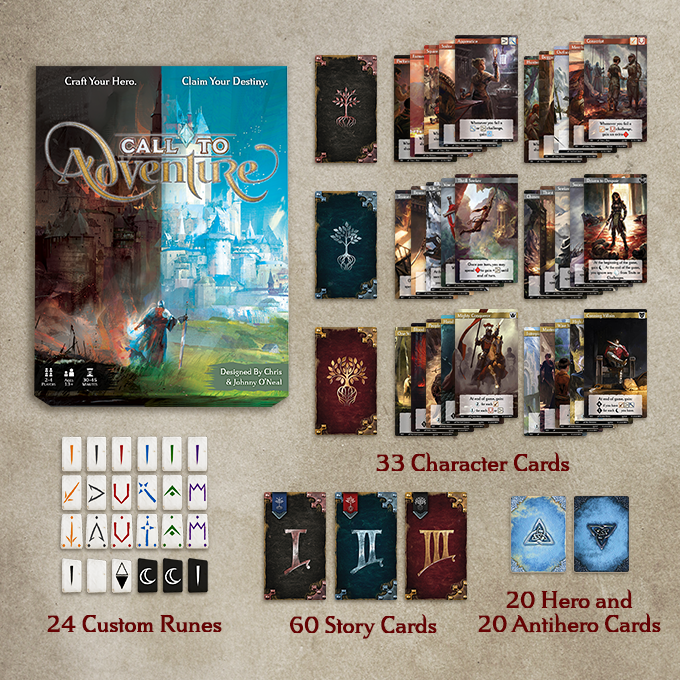
This game comes with a lot of components and a lot of very great art.
Don’t worry. Call To Adventure is a game that was designed to tell stories. No, not just tell stories: it lets you feel like the center of your own epic tale.
Telling A Story In 9 Cards
While Call To Adventure has a few twists, I’ve found that explaining what you are trying to do in this game is refreshingly simple: you are trying to tell a great tale of a hero – or antihero – who is rising to achieve their destiny. You give someone the hero card, motivation card, and secret destiny card for them to play a game with, and they get the theme immediately. In a full game, you deal out two of these to each player to let them choose their optimal route to victory points, but a random deal can be very fun as well.
In the course of teaching this game, I’ve been a noble who was bound by honor, their secret destiny to become a champion of the people. I’ve also been a farmer who was driven to darkness by an unknown act, but they were always secretly destined to become a hero. While some of the strategies to win Call To Adventure take one play through to really understand, it can be easy just to play to try and tell a compelling story. Don’t worry; the twin goals of winning and storytelling often will match up nicely.
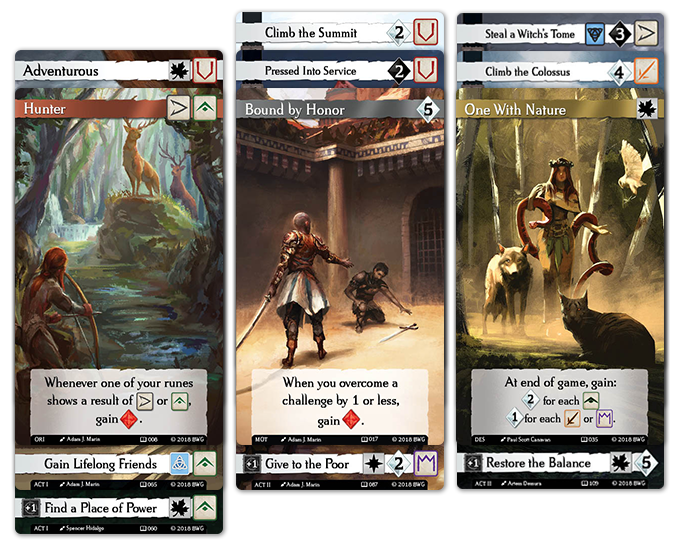
This is a great example of a character's final board. The left is their origin, the middle is their motivation, and the right is their destiny. The cards underneath each section are challenges and traits they've acquired over the course of the game, giving them new benefits.
The game board itself is set up a little like Splendor, with three decks of cards revealing three different acts in the life of the character you are playing. Each round, you’ll be trying to acquire a card from an act until you have three of each. Act I is a mixture of traits and challenges: traits are cards you can acquire just by spending experience points or managing a pre-requisite skill, while challenges give you a choice of earning an upgrades by throwing runes.
Throwing runes? Why yes. In one of the most inspired choices I’ve seen in a board game for a while, Call To Adventure eschews standard dice and replaces them with a tray of runes. These essentially are two-sided die, but their look and style help immerse you into the game mechanics. You get a standard three runes for every challenge, each giving you a chance to earn one success, but there are ways to strengthen your rune-pool that correspond to your original choice of character cards and the other challenges and traits you defeat. For example, if you've already challenged the card where you enact a street fight, you can acquire it to either gain another strength rune or dexterity rune to use on challenges later in the same game. You can spend experience points to add 'dark runes' to your pool, at the danger of corrupting yourself... and you can use hero/antihero cards that can be acquired in a multitude of ways to stack the odds. One thing about Call To Adventure is that there are a lot of options in a relatively small game.

A player board while still trying to acquire new story cards.
Each card you collect adds power to your tableau, but it also adds to what’s becoming your own epic tale. Maybe you’ve endured the flames of a house fire or found a way to negotiate through an armed robbery in the last turn. As the next card pick looms, you find yourself thinking strategically but also thematically; is it a better story that I find a restless spirit in the swamps, or go to fight a giant wolf in a cave? There is a lot going on in Call to Adventure, but I must stress at how much it accomplishes in just trying to collect nine cards. By the time you hit Act III, you've moved from surviving robberies and ghosts to taking on assassins' guilds and armies of the dead.
Betting To Create Your Own Fate
You are playing this game to make a story. Indeed, even the rulebook says that one of the best parts of the game is each player trying to thread together a cohesive tale of what their hero (or villain) accomplished in their rise to power. It’s compelling as a concept, but its how Call To Adventure merges this theme with its gameplay and point mechanics that turns it into a keeper.
To actually win Call To Adventure, you attempt to accumulate points in various ways. There are light colored diamonds for hero points, and dark colored diamonds for anti-hero points; they both count in equal measure towards winning the game, but the hero/motivation/destiny that you choose might sway you to try for one more than the other. The orange experience points count as well, but spending them to succeed on various tasks might be more valuable.
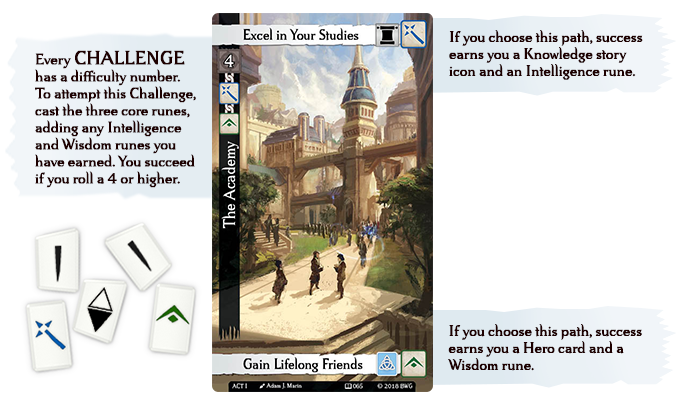
You get victory points for each card you manage to play, and you also get a bonus for collecting story icons. The icons are again, another ball to juggle in terms of getting points during the game. Completing a mission early on about going to wizarding school might get you more intelligence, but it can also have an Arcana icon. In act three near the end of the game, there’s a card where you effectively fight a wizard dual that also has Arcana on it. Sure, going for other cards might be worth more points outright, but theming your adventure around icons is a way to get points and make your journey have a lot of connecting tissue.
Something I’ve come to appreciate in board games is when the design allows you to achieve victory not through just one path, but by navigating which path is best. A lot of Call To Adventure isn’t trying to determine how to get points, but how to get the most with each turn. Getting nearly any card is a chance to get some points, but victory comes from theming your cards around getting hero points, anti-hero points, story icons, or just going wild on your destiny bonus. You won’t know who really won until the final totals are scored.
Throwing Runes, Casting Stories
Right out of the gate, I want to share my appreciation for Call To Adventure’s ability to just be picked up and played. As someone that teaches a lot of board games, I’ve found that many of them need a little bit of explaining and hand holding; people who want to know the theme or ‘plot’ want to understand their motivation. People who play for high victory point totals want a breakdown of how they move their marker the furthest along the board. Game set ups are often slowed to a crawl as rules are interrupted by people asking how the point system works, or why exactly a particular action is done thematically.
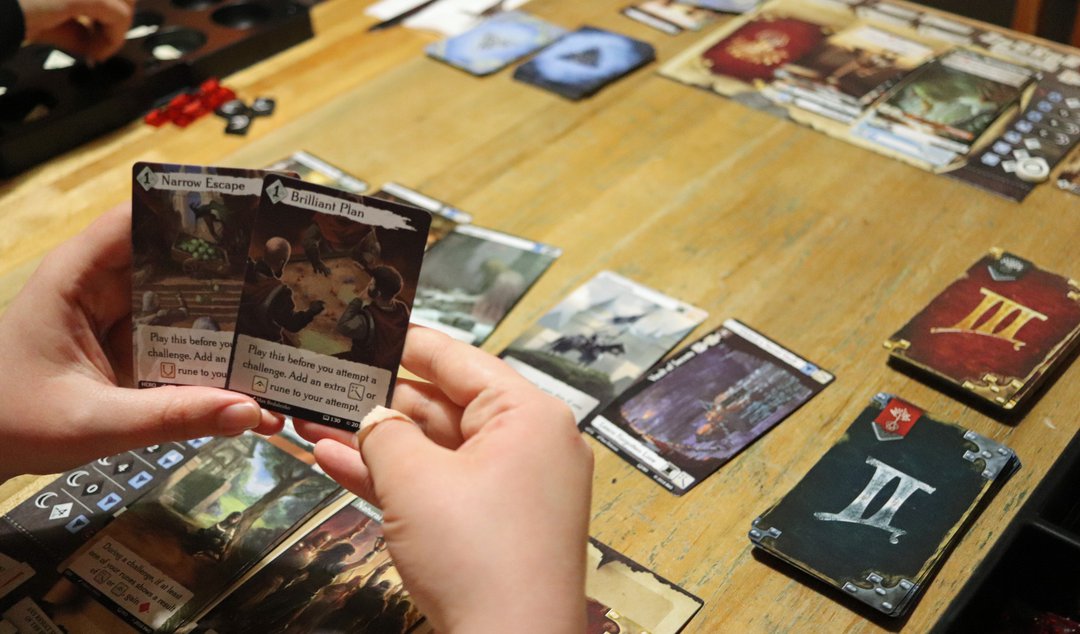
Hero and Anti-hero cards can be used as ways to make or break certain
Call To Adventure has found a way to merge form and function in a way that feels almost magical. After teaching the game to nearly two-dozen people, I’ve only had two people who walked away who didn’t want to play the game again. It has a universal component to its theme, just like Star Wars: the idea of someone wanting to discover who they are and become a legend. The gameplay itself makes a ton of sense once people accept that you are effectively using two-sided die to play and not something more standard. One more thing going for it is the speed; the first game might take a while to explain the rules, but when everyone around the table knows how to play it takes less than an hour to play.
When I first started reviewing board games, a common trend I saw from other players or reviewers was how many games either had a good theme or good mechanics, but the two never quite merged. To me, Call to Adventure has made these inseperable thanks to their use of art, tone, and pieces. That alone is a feat that makes it worth trying this game.
The Fun and Frustration Of New Components
If there is one issue that I can say Call to Adventure has, its going to be in how people adapt to playing it. While the concept itself is very straight forward, I did occasionally have a hard time expressing how the whole package went together. Some of my euro-game and victory-oriented friends wanted to ask where the points were hiding. They are in the game, but often don’t appear until later acts. Other points ‘hide’ in the story icons that you collect early on, something that players might not quite understand are important during their first playthrough. While I think Call To Adventure is a game that’s fun to play without winning, this might put off a few players who like more direct competition and point systems.
If I had one other suggestion, it would be to bring a dice tower, bowl, or tray. As I’ve said, the runes themselves are a very inspired choice, but I also know that there are a lot of them in the box; they can become hard to keep track of. One player might need to use 2 dexterity runes, 3 standard runes, and 1 charisma rune on their turn, and the next player needs an entirely different set. Using the component insert (which I love) that Call to Adventure comes with is important, and having a set place to throw the runes on the game table will help keep the game moving. Otherwise, you might spend some time turning over various runes looking for the right symbols between each turn.
The Endless Story Possibilities
Call To Adventure has been out for over six months now, and I’m happy to say that people still love playing it in our local group. Its mixture of random fates alongside differing starting points adds a lot to its replayability. What really makes me excited however is how this game is made with modularity in mind; the base game comes with its own small expansions which you can add or keep out of your games. One adds villains, tough monsters that can affect the board while they are on the field or give benefits when defeated.
The other base module adds allies, which are a new card subtype that attach to challenges; defeat a challenge, and acquire the ally for your area. It could be a childhood friend, a princess, or many other fantasy side-kick like tropes. They often give you a small bonus like victory points or a story icon, but they can also be sacrificed to get an immediate effect. It’s another layer onto the base game that isn’t overly complicated, but I like that I can add or take away this additional rule without affecting the basic flow of the game dramatically.
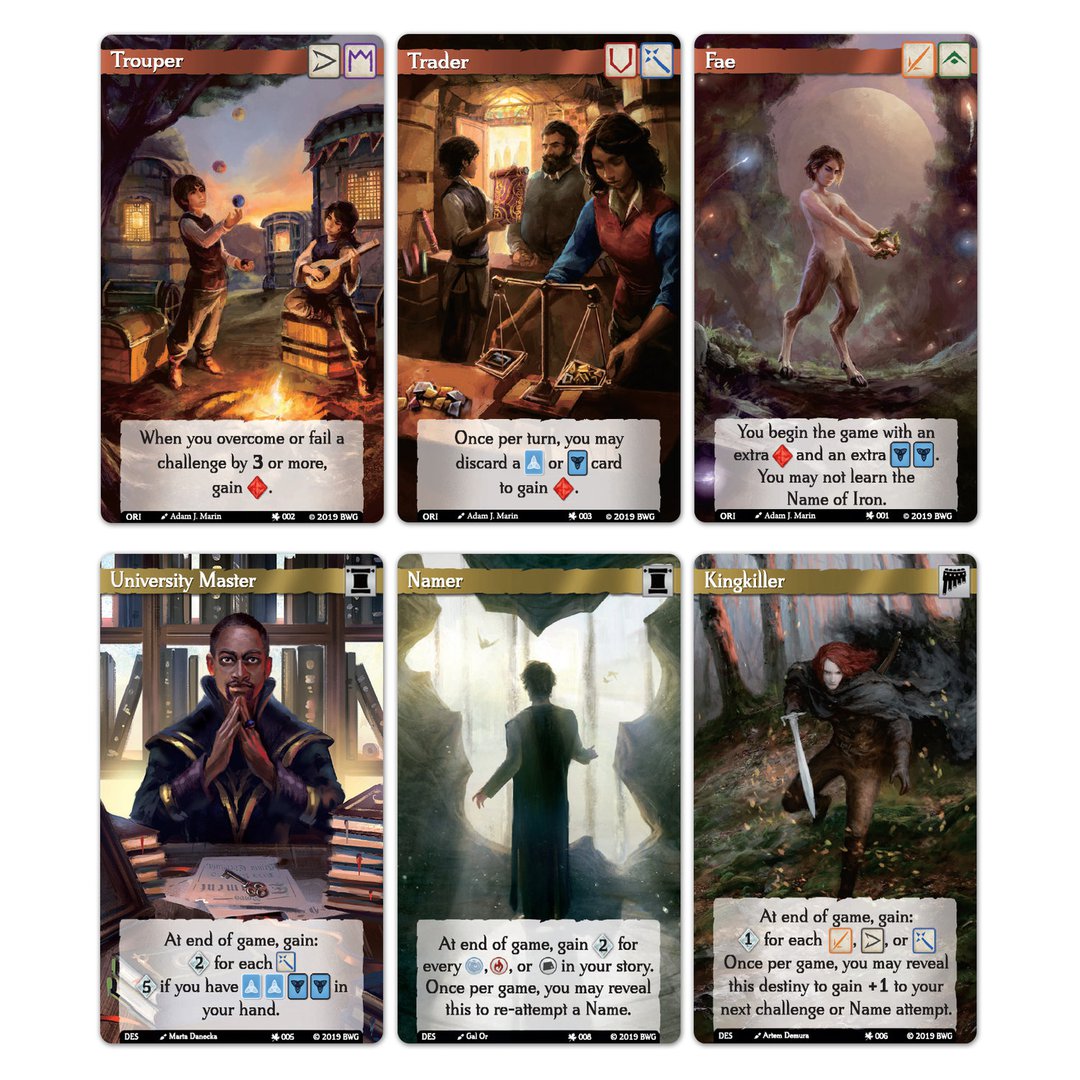
These cards from the first expansion of Call To Adventure demonstrate how many more possibilities this game has left to explore.
The real benefit though is just starting to be explored. Brotherwise Games recently announced partnerships with two writers you might have heard of: Patrick Rothfuss and Brandon Sanderson. Their first expansion, The Name Of The Wind, is already out, and takes your game into the realm of the Kingkiller Chronicle books to create new possibilities. It adds a ‘naming’ mechanic like what’s possible in Rothfuss’s stories, and firmly places the theme of your Call To Adventure game into heroic fantasy.
A new standalone expansion is coming out in 2020, based on The Stormlight Archive series by Brandon Sanderson. After that, the possibilities feel endless. I’d love to see a gothic horror take on the game, adding more supernatural elements of becoming dark monsters. You could even transport your game into a steampunk like setting, or take your characters out to see for a more pirate-like tone. This is a great game, but in the end, I really appreciate how its also a system of sorts, one that still has so much potential left to be seen.
Call To Adventure Is A Game That Deserves To Tell Many Stories
I can’t give enough praise to Call To Adventure. It’s a game that understands game mechanics, the importance of theme, and how to have fun while balancing both. Oftentimes, the board game community has a conversation about how important mechanics are over theme, or how much theme is needed before mechanics matter. In a lot of ways, this is the game that has managed to thread a very tough needle. After playing over a dozen games, its still in my game bag, and I still have people requesting to play at our game nights.
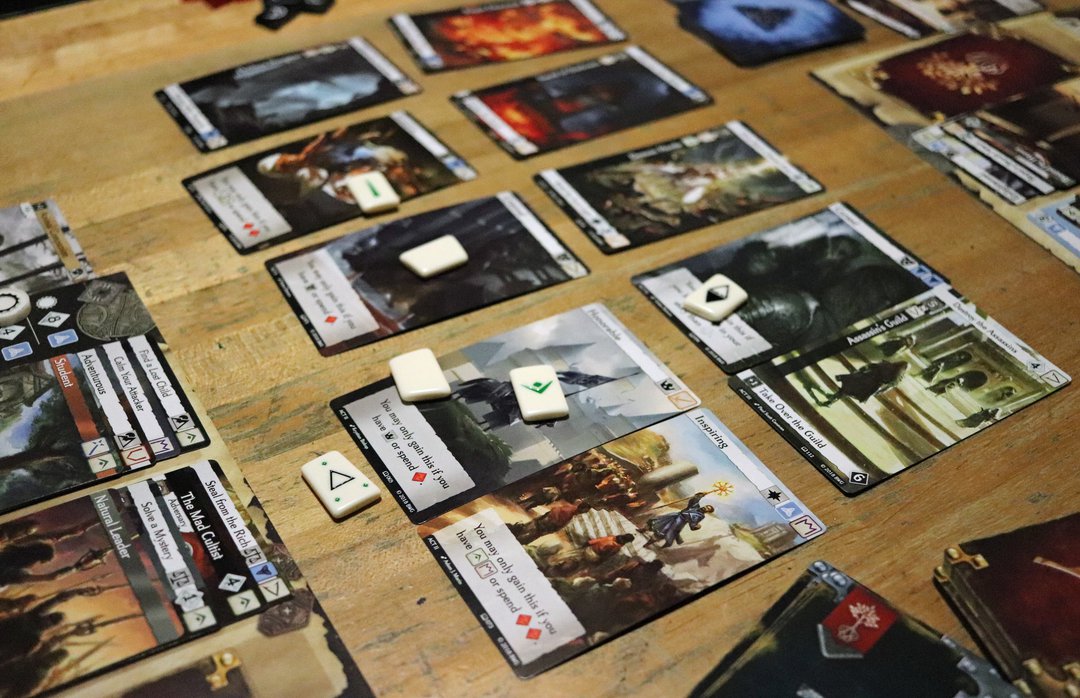
Whether you want to feel the thrill of character creation or the fun of rolling dice with friends, Call To Adventure deserves a space in your collection.